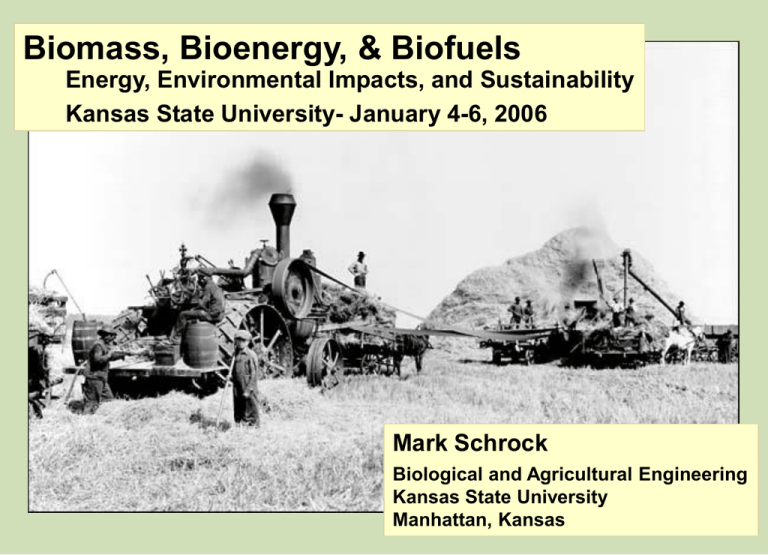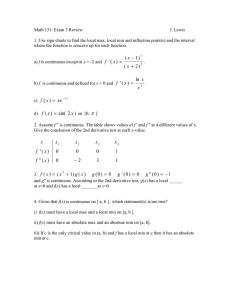Biomass, Bioenergy, & Biofuels
advertisement

Biomass, Bioenergy, & Biofuels Energy, Environmental Impacts, and Sustainability Kansas State University- January 4-6, 2006 Mark Schrock Biological and Agricultural Engineering Kansas State University Manhattan, Kansas 25000 Petroleum Consumption Trends Oil Consumption, thousand bbls/day 20000 USA Europe Former Soviet Union Middle East Africa Asia Pacific 15000 10000 5000 0 1965 1970 1975 1980 1985 Year 1990 1995 2000 2005 Source: BP, 2002 Approximate 2005 “Global production of conventional oil will begin to decline sooner than most people think, probably within 10 years” C.J. Campbell and J.H. Laherrere Scientific American—March 1998 No One Really Knows... “There’s plenty of cheap oil, says the US Geological Survey” Eric Niiler Scientific American—September 2000 Comparing the Energy Market to Agriculture US Vehicle Fuel Consumption, 1999 Billion Gallons Gasoline 123 Diesel Fuel 33 Source: DOE Agriculture’s Energy Potential: Energy contained in U.S. grain crops, total above-ground biomass. Grain Record Grain Residue Year of Bushels Weight Weight 1 Record (Millions ) (lbs/bu) (lbs/bu) AboveBiomass Energy Biomass Ground Gasoline Equiv.3 Energy2 Biomass (BillionBTU) (BillionGal) (MillionLbs) Corn 11,800 2004 56 56 1,321,600 9,912,000 85.4 Grain Sorghum 1,120 1985 56 56 125,440 940,800 8.1 Wheat 2,785 1981 60 100 445,600 3,342,000 28.8 Soybeans 3,120 2004 60 50 374,400 2,808,000 24.2 Total 146.5 Notes: 1. USDA-NASS, 2. Assumed 7,500 BTU/lb, 3. Assumed 116,000 BTU/gal US Gasoline Consumption ~123 Billion Gallon Conclusion: Energy is a MUCH larger market than food. Relative Food and Energy Prices 60 50 Price, $/unit 40 Prices in Current Dollars Wheat, $/Bushel Crude Oil, $/Barrel 1973: 1 Bushel bought 1 Barrel 2005: ~17 Bushels bought 1 Barrel Winter Wheat Crude Oil 30 20 2005: 1 Bushel of Wheat bought 1 GALLON of Diesel fuel. 10 0 1950 1960 1970 1980 Year 1990 2000 Will Energy Put a Floor Under Grain Prices? 1.4 1.2 Price Ratio 1 Crude Oil Price / Wheat Price Equal Energy Basis Crossover 2004? Assumed LHV: Wheat @ 7,500 BTU/lb Crude @ 19,000 BTU/lb 0.8 0.6 0.4 (On an energy basis, Grain Sorghum is currently less than half the price of crude oil.) 0.2 0 1950 1960 1970 1980 Year 1990 2000 The Successor to Petroleum for Transportation has NOT been Identified BioFuels (ETOH, Biodiesel, Methane) PV or Wind>>Hydrogen>>Fuel Cell? PV or Wind>>Batteries? Coal-Derived Liquids>>IC Engine or Fuel Cell? ALL Major Auto Makers (and DOE, USDA, etc) Have Active R & D… Hydrogen Issues: • Supply/Cost • Storage • Range • Safety MDS Prediction: This WON’T be cheap. Moving Transportation Beyond Petroleum Conserve Change Transportation Mode Mix Transition to Renewables Current 1949 1964 1973 2005: Class 8 Trucks Burn ~ ½ of US Diesel fuel Comparing Transportation Modes Current Fuel: • Diesel • Electricity • Coal • Wood Future Fuel: Above, plus Fuel Cells? 1 Degree of Freedom (always on track) + Steel On Steel (Low Crr, Weight Tolerant) = Wide Fuel Flexibility Our most omnivorous mode of transportation Fast Passenger Rail (French TGV, Japanese Bullet Train) • First TGV powered by Gas Turbine (ca. 1972) • Changed to Electrical Power in Response to Arab Oil Embargo, 1974 • In Regular Service since 1981 ~ 80% of France’s Electricity is Nuclear Container Freight Multi-Mode •Ship •Train •Truck Comparing Transportation Modes Current Fuel: • Gasoline (SI) • Diesel (CI) Future Fuel: • Liquids • Fuel Cell? • Battery? 2 Degrees of Freedom Moderate Weight Sensitivity Comparing Transportation Modes Current Fuel: • AvGas (SI) • Jet A, JP-4 (Turbines) Future Fuel: • Liquids • (Incl. Biodiesel) • Alternatives (Fuel Cell, etc) are tenuous! Three Degrees of Freedom Very High Weight Sensitivity Very Demanding Fuel Requirements Aircraft Weight Sensitivity Example: Boeing 747- 400 from Tokyo—New York Take-Off Weight = 375 Tons Landing Weight = 250 Tons Fuel Burn = 125 Tons Fuel Reserve = 25 Tons Fuel > 1/3 of Take-Off Weight Source: Boeing Forms of Photosynthesis Green Plants C4 Purple Bacteria Cyanobacteria C3 Efficiency of Photosynthesis Sunlight to Sugar 11% is Absolute Top Theoretical Efficiency Losses are Estimated at: Evolutionary Survival 20-25% Respiration (Structure, etc) 20-100% So New Practical Peak = ~5% Source: Smil Efficiency of Photosynthesis Crassulacean Acid Metabolism Separates (in time) energy absorption And carbon fixation Most Common Limit to Photosynthesis is WATER Lowest Transpiration Loss: 400-500 moles H2O per mole CO2 Fixed Source: Smil Comparing Photosynthetic Pathways Saturation of Radiation, W/m2 C3 300 C4 None Best Temperature, oC 15-25 30-45 Moles H2O per mole CO2 Fixed: 900-1200 400-500 Maximum Daily Growth: g/m2 34-39 50-54 Daily Max, Average for Season: g/m2 13 22 Source: Smil Example: Photosynthetic Efficiency of Corn Given: Average Radiation = 210 W/m2 Grain Yield = 200 bu/acre Grain Energy = 17 MJ/kg Growing Season = 150 days Total Season Radiation: 210 W/m2 * 3600 * 24 * 150 = 2.72 * 109 J/ m2 Grain Energy: 200 * 56 * 17 * 2.47/2.2 = 2.1 * 105 MJ/ha Photosynthetic Efficiency (Grain Only): 2.1 * 105 MJ/ha / 2.72 * 109 J/ m2 = 0.77% Example: Photosynthetic Efficiency of Corn If Stover is Harvested, and MOG/Grain = 1: Photosynthetic Eff Would ~Double To ~ 1.5% Solar Conversion Efficiency C3 Crops 0.1-0.7% Best C4 (Sugar Cane) 1.5-2.5% Global Mean ~0.3% Kansas Farmland (0.5%) $500-4000/ac PV Array (12%) $2,000,000/ac Source: Smil BioEnergy Issues: Does it Really Produce Energy? Energy Profit Ratio = Energy Out / Energy In Energy Profit Ratio US Domestic Petroleum 30 Energy Profit Ratio 25 20 15 10 Production vs Mining… 5 Source: Gever, et al. (1986) 0 1915 1925 1935 1945 1955 Year 1965 1975 1985 Agricultural Energy Inputs: Production Direct – – – – Field Operations Irrigation Grain Drying Management Embodied – – – – Fertilizer Seed Chemicals Machinery Energy Outputs: Fuel – ETOH – BioDiesel – Others CoProduct – DDGS – Gluten Feed – Seed Meal – Pesticides – Others The CoProduct may have more value (both $ and BTU) than the fuel. Energy Inputs for Corn Production: Total Inputs = 49,753 btu / bu 17,000 btu/bu 27,000 btu/bu Seed Fertilizer Energy Custom Work Chemicals Misc Source: Shapouri, Duffield, & Wang, 2004 Energy Balance for Ethanol Production: W/Credits No Credits W/Credits Adjusted BTU/Gal. BTU/Gal. BTU/Gal. Corn Production 18713 12350 18713 Corn Transport 2120 1399 2120 Ethanol Conversion 49733 30586 49733 Ethanol Distribution 1487 1467 1487 Total Energy Used 72052 45802 72052 Net Energy 4278 30528 30528 Ethanol Energy Value 76330 76330 102580 1.06 1.67 1.42 Energy Out/In Source: Shapouri, Duffield, & Wang, 2004 Opportunities for Improving Ethanol’s Energy Balance: Corn Fertilization, especially Nitrogen Ethanol Processing (Cogen) Biodiesel Energy Profit Ratio: Biodiesel Feedstocks: wide variety of plant oil and animal fats. The most comprehensive analysis (Sheehan, et al, 1998) considered Soybean oil (>300 page report). Conclusion: Soy Biodiesel EPR = 3.21. Other feedstocks (esp. non-legumes) will have lower/higher EPR. Fossil Inputs to Soy Biodiesel: MJ Fossil/MJ Biodiesel Soybean Agriculture 0.0656 Soybean Transport 0.0034 Soybean Crushing 0.0796 Soy Oil Transport 0.0072 Soy Oil Esterif. (incl. MEOH) 0.1508 Biodiesel Transport 0.0044 Total 0.3110 Source: Sheehan, et al., 1998 Other Biodiesel EPRs: Energy Out/Energy In Corn Oil, Illinois 3.95 Cotton Seed Oil, Texas 1.76 Crambe, Kentucky 3.11 Peanut, Georgia 2.26 Spring Rape, Canada 4.18 Safflower, California 3.39 Soybeans, Illinois 4.56 Sunflowers, North Dakota 3.5 All Crops Dryland Production Source: Goering & Daugherty, 1982 Basic Esterification: Low Pressures Low Temperatures Esterification Reduces Viscosity Source: Clark, et al., 1984 (KSU) Biodiesel Properties: Unit Diesel MESO Specific Gravity kg/L 0.82-.85 0.86-.90 Viscosity Cst Lower Heating Value MJ/kg Cetane Number Flash Point C 2-3 3.5-5 42-43 40 45-49 48 74 >100 Source: Clark, et al., 1984 (KSU) Power From Soy Esters Source: Clark, et al., 1984 (KSU) Desirable Traits for Energy Crops Legume (or low protein product) Perennial (low energy inputs) Low Processing Energy Good Yields on Dryland Two Paths: Adapt food crops to energy production Domesticate new energy crops Soybean Glycine max Temperate Legume Annual Cultivated for 3000 yrs Seed Yield 3.1 Mg/ha Oil Content 17-26% Oil Yield 650 kg/ha Seed Yield 2 Mg/ha (30 bu/ac) Oil Content 18% Oil Yield 360 kg/ha (46 gal/ac) Ref: CIGR V. Sunflower Helianthus annus Temperate Annual Seed Yield 3.7 Mg/ha Oil Content 35-40% Oil Yield 1400 kg/ha Ref: CIGR V. Seed Yield 1.7(dry)-3.4 (irr) Mg/ha Oil Content 40% Oil Yield 700-1400 kg/ha (90-180 gal/ac) Ref: KSU Hybrid Trials Peanut Arachis hypogaea Temperate Annual Legume Seed Yield 5 Mg/ha Oil Content 36-50% Oil Yield 2000 kg/ha Seed Yield 2.5 Mg/ha (irr) Oil Content 48% Oil Yield 1200 kg/ha (150 gal/ac) Ref: CIGR V. Ref: KSU (ASAE MCR85-142) Castor Ricinus communis Temperate Perennial Grown as Annual Ricin (potent toxin) Seed Yield 5 Mg/ha Oil Content 35-55% Oil Yield 2250 kg/ha Ref: CIGR V. (285 gal/ac) Lubricant “Castrol” Grown in SW KS & TX panhandle, WWII era. Rape Canola (low erucic Rape) Brassica napus Idaho Biofuels Program Temperate Annual Pacific NW, Canada, China Seed Yield 3 Mg/ha Oil Content 33-40% Oil Yield 1100 kg/ha (140 gal/ac) Ref: CIGR V. Safflower Carthamus tinctorius Temperate Annual Pacific NW Seed Yield 4.5 Mg/ha Oil Content 25-37% Oil Yield 1300 kg/ha Ref: CIGR V. Crambe Crambe abyssinica Temperate Annual German-French Tests (dry): “dt” = 100 kg Seed Yield Oil Content Oil Yield 5 Mg/ha 36% 1800 kg/ha (225 gal/ac) Ref: CIGR V. Plant-Derived Liquid Fuels Four Options Table 1. Liquid biofuels by feedstock and land class. Starch and Cellulose-Based Arable Land Nonarable Land Ethanol from Grain Cellulosic Ethanol from Perennials (herbaceous and woody) Ethanol from Crop Residues Lipid-Based Biodiesel from Annual Oilseeds Biodiesel from Perennial Oilseeds Expanding Land Available for Energy: Perennial vs. Annual Agriculture Factors that Render Land Non-Arable: • Steep Slopes • Shallow Topsoil • Sandy Topsoil • Surplus or Deficient Water • Variable Climate • Rocks Perennial Agriculture SHOULD BE far less vulnerable. Class IV Land: Marginally Arable Sandy Topsoil (High Erosion & Low Water Capacity) Perennial Windbreak Temporary Windbreak (reduces wind erosion) Winter Wheat (intended crop) Water Table < 5 m. Deep Why Force Marginal Land Into Annual Agriculture? Kansas Cash Rental Rates: Rangeland $31.12/ha Non-Irrigated Cropland $88.92/ha Kansas Land Use: Rangeland 6.7 x 106 ha Cropland 12.7 x 106 ha Total Land Area 21.2 x 106 ha Is $15/ac the Best We Can Do? Biodiesel From Perennial Oilseeds Potential Benefits: •Utilize Marginal Land •High Energy Profit Ratio •Low Processing Energy Kentucky Coffee Tree Gymnocladus dioica Large (20 m. tall) Legume Cotyledon: 32% protein, 23% fat Oil Yield ~ 200 l/ha Chinese Tallow Tree Sapium sebiferum Tropical Perennial Invasive Weed in Florida, Texas Seed Yield 14 Mg/ha Oil Content 55% Oil Yield 7700 kg/ha (970 gal/ac) Ref: CIGR V. Jatropha curcas Tropical Shrub ~ 3 m tall E. Africa Seed Yield 8 Mg/ha Oil Content 50% Oil Yield 4000 kg/ha (500 gal/ac) Ref: CIGR V. African Oil Palm Elaeis Guineensis West Tropical Africa Oil Yield 2200 kg/ha (280 gal/ac) Ref: CIGR V. Annual Production or Consumption, Million gal Kansas Transportation Energy vs Land Resource 2500 2000 CRP + ¼ Range + 1/10 Cropland CRP + ¼ Range 1500 1000 1/3 Current Diesel + Gas Use 500 CRP Only 1/3 Current Diesel Use 0 0 50 100 150 Fuel Yield, gal/acre 200 250 $3+/gal Gasoline For DECADES Energy vs. Prosperity 50000 45000 Switzerland U.S. 40000 Japan GDP, $/Capita 35000 30000 France 25000 Canada 20000 15000 10000 5000 Russia China 0 0 1000 2000 3000 4000 5000 6000 7000 8000 9000 Energy Use, kg Oil/capita Source: Economist World in Figures, 2006 “The Americans will always do the right thing... after they’ve exhausted all the alternatives.” Sir Winston Churchill


